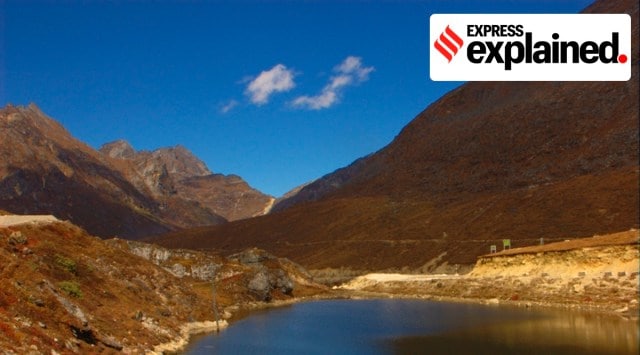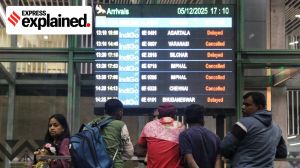Understanding the disputed LAC and China’s claims over Arunachal
The LAC is more heavily contested in the Western Sector, and there are more frequent incursions in Ladakh than in the Eastern Sector. What is the origin of the border dispute with China?
 A lake at Se La in Tawang district of Arunachal Pradesh. The LAC separates Indian-controlled territory from Chinese-controlled territory. It is divided into the Eastern Sector (Arunachal Pradesh and Sikkim), Middle Sector (Uttarakhand and Himachal Pradesh) and Western Sector (Ladakh). (Photo: Wikimedia Commons).
A lake at Se La in Tawang district of Arunachal Pradesh. The LAC separates Indian-controlled territory from Chinese-controlled territory. It is divided into the Eastern Sector (Arunachal Pradesh and Sikkim), Middle Sector (Uttarakhand and Himachal Pradesh) and Western Sector (Ladakh). (Photo: Wikimedia Commons). Something that is repeatedly referred to in analyses of Chinese incursions along the Line of Actual Control (LAC) is the undefined nature of the Himalayan border. Following the clash on December 9, a military source told The Indian Express: “In certain areas along the LAC in the Tawang sector in Arunachal Pradesh there are areas of differing perception, where both sides patrol the area up to their claim lines. This has been the trend since 2006.”
Preparing for UPSC? Use CRACKUPSC20 code here to get an extra 20% discount on Indian Express subscription.
The LAC is more heavily contested in the Western Sector, and there are more frequent incursions in Ladakh than in the Eastern Sector.
What is the origin of the border dispute with China?
After the communists took power in China, they pulled the country out of all international agreements and the so-called “unequal treaties” that had been imposed on it during its “century of humiliation”, and demanded a re-negotiation of all its borders.
The border between China and India has never been delimited. In January 1960, the politburo of the Chinese Communist Party decided to open negotiations with India and reach an understanding through “mutual understanding and mutual concessions”.
In April that year, China’s Premier Zhou Enlai and Prime Minister Jawaharlal Nehru agreed on a detailed examination of the claims by officials. Over the next two years, both sides sought to preserve their claims by posting troops along the border. In the 1962 war, the PLA quickly overpowered the Indian troops.
What is the Line of Actual Control (LAC)?
The LAC separates Indian-controlled territory from Chinese-controlled territory. It is divided into three sectors: the Eastern Sector (Arunachal Pradesh and Sikkim), Middle Sector (Uttarakhand and Himachal Pradesh) and Western Sector (Ladakh).
India and China do not agree on the LAC. India considers the LAC to be 3,488 km long; the Chinese consider it to be only around 2,000 km. There is the least disagreement in the Middle Sector.
In the Eastern Sector, the alignment of the LAC is along the McMahon Line, which takes its name from Sir Henry McMahon, foreign secretary of British India, who drew the 890-km line as the border between British India and Tibet at the 1914 Simla Convention Between Great Britain, China, and Tibet.
The line, drawn primarily on the highest watershed principle, marked out previously unclaimed/ undefined borders between Britain and Tibet, and included Tawang in the British empire. China disputes the high watershed principle, and some of the positions on the ground that follow.
In November 1959, Premier Zhou wrote to Prime Minister Nehru saying the LAC was “the so-called McMahon Line in the east and the line upto which each side exercises actual control in the west”. (Shivshankar Menon; ‘Choices: Inside the Making of India’s Foreign Policy’)
India rejected this, and during the 1962 war, Nehru said: “There is no sense or meaning in the Chinese offer to withdraw twenty kilometres from what they call ‘line of actual control’. What is this ‘line of control’? Is this the line they have created by aggression since the beginning of September (1962)? Advancing forty or sixty kilometres by blatant military aggression and offering to withdraw twenty kilometres provided both sides do this is a deceptive device which can fool nobody.” (Menon; ‘Choices’)
In both 1959 and 1962, India’s position was that “the Chinese concept was a disconnected series of points on a map that could be joined up in many ways”, Menon wrote.
In his book ‘How India Sees the World’, Shyam Saran wrote that the LAC was discussed during Chinese Premier Li Peng’s 1991 visit to India, and India formally accepted the concept when Prime Minister P V Narasimha Rao paid a return visit to Beijing in 1993. The two sides signed the Agreement on the Maintenance of Peace and Tranquility along the Line of Actual Control; however, the reference to the LAC was unqualified to make it clear that it was not referring to the LAC of 1959 or 1962 but to the LAC at the time when the agreement was signed.
What is China’s so-called claim on Arunachal Pradesh, and on what grounds?
China claims some 90,000 sq km of Arunachal Pradesh — the entire state — as its territory. It calls the area “Zangnan” in the Chinese language and makes repeated references to “South Tibet”. Chinese maps show Arunachal Pradesh as part of China, and sometimes parenthetically refer to it as “so-called Arunachal Pradesh”.
China makes periodic efforts to underline this unilateral claim to Indian territory. As part of this strategy, it has tried to give Chinese names to places in Arunachal Pradesh — it published a list of six such names in 2017, and another 15 names in 2021.
India has dismissed the Chinese “invention” of these names. Last year, the Ministry of External Affairs said in a statement, “Arunachal Pradesh has always been, and will always be, an integral part of India. Assigning invented names to places in Arunachal Pradesh does not alter this fact.”
At the 1914 Simla Convention where the McMahon Line was drawn, China was represented by a plenipotentiary of the Republic of China, which had been declared in 1912 after the Qing dynasty was overthrown. (The present communist government came to power only in 1949, when the People’s Republic was proclaimed.) The Chinese representative did not consent to the Simla Convention, saying Tibet had no independent authority to enter into international agreements.
- 01
- 02
- 03
- 04
- 05






































